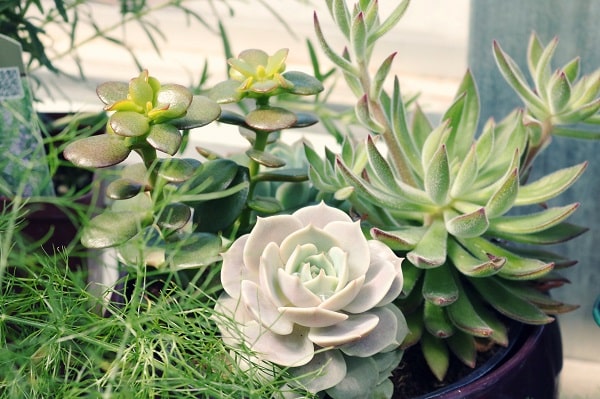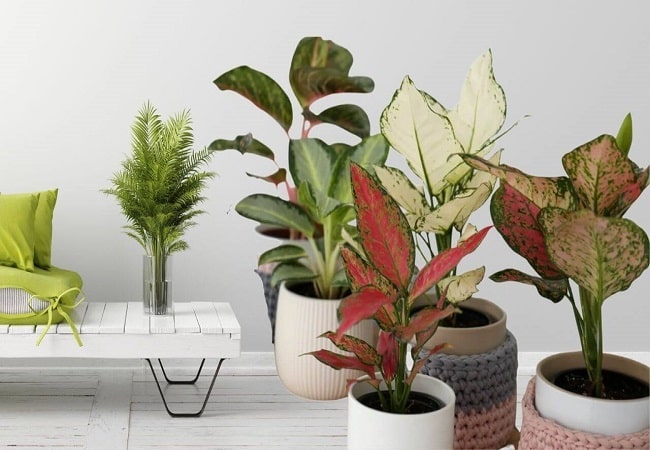Succulents are a group of plants that have adapted to a dry environment. They have fleshy leaves and stems that can store water, which helps them survive periods of drought. Succulents are popular because they look nice in a garden, don’t require much maintenance, and are easy to propagate.
Outdoor succulents are perfect for planting in pots. They require little maintenance and can grow in a variety of climates. Succulents are drought tolerant and grow quickly, making them an ideal choice for gardeners who want to add a bit of color and personality to their landscape.
In this article, I will discuss the best succulents for outdoor pots and care tips for outdoor potted succulents. Stay tuned for more information!
Quick Navigation
Choose The Perfect Pot Size For An Outdoor Succulent

Selecting the proper pot for your plants is essential because succulents come in various sizes and shapes. The following advice will help you choose the ideal succulent pot size:
- Take the plant’s size into account. Succulents come in various sizes, so pick a big enough pot to hold the roots but not so big that it makes maintenance difficult.
- Before making a purchase, determine the plant’s container’s circumference. Instead of relying on online reviews or eyeballing it, you can use this to determine whether a pot is appropriate based on its dimensions.
- Choose a drainage hole if necessary. Many succulent pots come with drainage holes, but if yours doesn’t, be sure to add one yourself before installing your succulent into its new home.
- Verify that the container you select has enough depth for the succulent. Planting should be done at a depth of about 2 inches for most succulents to ensure proper nutrient and water uptake.
- Be sure to add drainage gravel or crushed stone to the bottom of the pot if you’re using a clay pot or terra-cotta pot, as these will help keep your plants soil-free and hydrated.
- If you’re using a glass pot, buy a tempered glass container, so your succulence doesn’t get scratched or cracked when transported and stored outdoors.
The Best Succulents For Outdoor Pots

Succulents are a great option for outdoor pots because they are drought tolerant and low-maintenance. Here are some of the best succulents for outdoors pots:
Aloe Vera
Aloe Vera is a succulent that is very popular for its therapeutic properties. It can grow in various climates, including outdoors, and it is tolerant of sun and shade. Aloe Vera can grow up to 4 feet tall, making it a great choice for larger pots.
Echeveria
Another succulent with medicinal properties is Echeveria. It tolerates sun and shade and can be grown in various climates, including outdoors. Echeveria can reach a height of 6 inches, making it ideal for smaller pots or containers.
Sedum
Sedum is a hardy succulent that tolerates full sun or partial shade. It is one of the most drought-tolerant plants, perfect for areas with little water access.
Sempervivum
Sempervivum is a low-maintenance succulent that can tolerate dry and wet conditions. It will grow quickly in either clay or terra cotta pots.
Crassula
Crassula is a succulent that can tolerate various soils and temperatures. It grows quickly and has large, succulent leaves.
Sansevieria
The attractive, variegated leaves of Sansevieria make it a popular succulent. It tolerates both dry and wet climates and can be planted in full sun or partial shade.
Sedum Acre
Sedum acre is a dwarf form of the common sedum plant. It grows small (up to 2 inches tall) and produces dense clusters of narrow, green leaves.
Echeveria Agavoides
Unique succulent Echeveria agavoides are also called the “jade plant.” Large, striped leaves are produced, and it is simple to grow.
Where To Place Your Outdoor Succulent Pot?
Succulent plants make great additions to any outdoor pot, but there are a few things to remember when choosing where to place them.
- First, succulents need plenty of sunlight and well-drained soil, so choose a spot with plenty of natural light.
- Second, avoid placing succulents near trees or tall plants, as they may be grazed on.
- Finally, ensure the soil you choose is well-aerated and free from heavy clay or rock content, as these elements can damage succulent roots.
The Benefits Of Outdoor Succulent Pots
Succulents are perfect for outdoor pots because of their drought-tolerant nature and ability to grow in various soil conditions. Additionally, succulents are easy to grow, requiring little maintenance and minimal effort to provide a lush garden look.
Here are a few benefits of using succulents in your outdoor landscape:
- Succulent plants are inexpensive and simple to add interest and color to any garden space.
- Succulent plants can help reduce water usage by absorbing it through their leaves instead of letting it run off the ground.
- Succulent plants are low-maintenance focal points that only need to be watered occasionally.
- Succulent plants can tolerate a wide range of soil conditions, making them ideal for gardens with varying degrees of moisture or sun exposure.
- Succulent plants typically bloom sporadically rather than continuously, meaning they don’t require regular fertilization or pruning, unlike many other plants.
- Since succulent plants typically have short lifespans, the garden can add new specimens yearly.
- Succulent plants can easily propagate from a cutting or piece of root.
Care Tips For Potted Outdoor Succulent
For gardeners and landscape designers looking for plants that can thrive in various climates, succulents are a popular option. Many succulent varieties can be grown outdoors, but they must be properly cared for to stay healthy. Here are some pointers for maintaining healthy succulent plants:
- Keep Succulents Well-Watered: Succulents need plenty of water to thrive, but too much water can also cause them to become root-bound and pot-bound. So make sure to give your succulent plants enough water, but not too much water, throughout the growing season. Watering succulents every two days in the summer and once weekly in the winter is a good general rule of thumb.
- Avoid Fertilizing Too Much: Overfertilizing your succulent plants can cause them to grow rapidly but also lead to nutrient deficiencies and even plant death. To avoid overfertilization, wait until the soil has dried before adding any additional fertilizer or amendments. Use a low-nitrogen fertilizer if needed.
- Feed Succulents Weekly in the Summer: Succulents are best suited for weekly feeding in the summer during the growing season. To feed succulents, water the plant well and then sprinkle a weak fertilizer over the soil surface. Repeat this process every two weeks in the summer.
- Prune Succulent Plants Sparingly: Pruning succulent plants can help to shape them into their desired form, but be careful not to prune too harshly as this can cause damage to the plant’s roots. To prune succulents, start by removing any dead or diseased branches from the base of the plant.
- Protect Succulent Plants From Frost: While succulents can withstand cold weather, frost will damage them if not protected. To protect your succulent plants from frost, place them in an area that receives at least six hours of direct sunlight daily.
- Remove Old Growth When Necessary: If old growth begins to grow excessively on your succulent plants, it is best to remove it periodically as it can cause damage to the plant’s stem and roots. To remove old growth, gently pull on the branch until it breaks off at the root and dispose of it properly.
- Replace Succulent Plants If They Deteriorate: If your succulent plants show signs of deterioration, such as wilting or drooping leaves, it is best to replace them with new plants rather than trying to keep them healthy by watering and fertilizing them regularly.
Frequently Asked Questions
Do Succulents Prefer Shallow Or Deep Pots?
Succulents do not prefer deep or shallow pots. The pot size is not as important to succulents as the soil mix, drainage, and exposure to sunlight and wind. A succulent will grow in a wide variety of pot sizes, but the depth of the pot should be no more than one-third the height of the plant.
What Succulents Can Stay Outside During The Winter?
Succulents are plants that can survive in cold climates. Some succulents that can survive the winter by staying outside are Agaves, Echeverias, Geraniums, Yuccas, and Zygophyllum. These plants typically have fleshy leaves and a thick stem that helps them to withstand cold temperatures.
What Is The Easiest Succulent To Grow?
Many succulents can easily grow, with a few notable exceptions. The easiest succulent to grow is likely a cactus, as they require very little water and do not take up a lot of room. Many other succulents, like the aloe vera, can grow in a pot or on the ground, and they will only require water when growing new leaves.
Can You Leave Succulents Outside In The Rain?
A water-sensitive plant is called a succulent. As a result, they require regular watering and shouldn’t be exposed to rain. The succulents will rot as a result of the water.
Will Succulents Come Back After A Freeze?
A succulent is a type of plant that is adapted to cold climates. Succulents are typically drought-tolerant and can survive freezing temperatures. However, succulents can die after a freeze. If the freezing temperature does not damage the plant’s tissues, the succulent may return after a freeze.
Conclusion
Succulents make great additions to outdoor pots, as they can withstand dry and wet environments. They are also easy to care for, requiring little maintenance other than watering occasionally. Furthermore, they can spice up any garden and serve as excellent conversation starters. So if you’re looking for an intriguing plant that can thrive in various conditions, succulents are worth considering!

My name is Md Deloar Hossain and I’m the creator of Club Gardening, designed for all your gardening ideas, gardening product reviews, and a place to help you find the best gardening experience possible.


